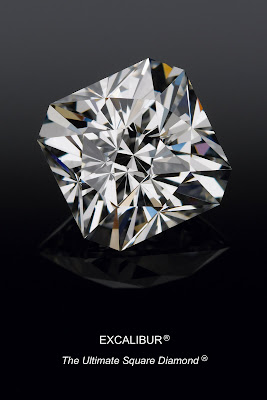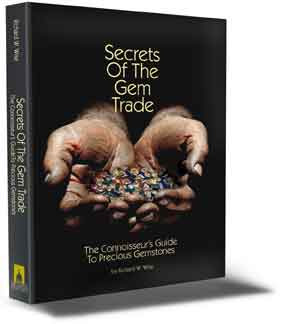This year I will be doing several projects for Colored Stone Magazine. To begin with I will be writing a market survey piece on the Hong Kong Gem and Jewelry Show. I love Hong Kong; hotels are reasonable, choice of restaurants amazing and the city fairly pulses with life. For those of you who visited Hong Kong a few years ago, things have changed. Remember those cute little umbrellas and those cheap silk embroidered dresses with the slits up the side well forget-about-it-gringo! In Hong Kong today the ladies shop Bally, Cartier and Prada. Believe it or not there are more Prada & Bally stores in Hong Kong than in the entire continental U. S.
The September Hong Kong is one of the big three shows. What goes on in Hong Kong Gem & Jewelry Show often sets the tone for Tucson and Basil. Last year, you’ll recall, I did a blog on pricing of cuprian, aka Mozambique “Paraiba” tourmaline. This year the net will be cast a bit wider.
David Federman has taken over as the helm at Colored Stone. For those who don’t know, David is the gem trade’s premier journalist. He is the author of several books and, without doubt, one of the most knowledgeable people out there. Look for some interesting changes at Colored Stone.
We are still working out the details but I believe you will be seeing my report online at Colored Stone’s website: www.colored-stone.com
I will be making a trip to the gem mines of Colombia in December and following up with a piece on old mine emeralds later in the year and with luck teaming up with that globe trotting French gemologist, Vincent Pardieu, for another series on exotic locals. Stay tuned.

Diamonds, diamonds and more diamonds!
Those of you who know me also know I am not a big fan of colorless diamonds. On the other hand, since 95% of the gems sold in the U. S. are, you guessed it, colorless diamonds, it behooves a jeweler to pay a bit of attention.
For the past decade, the big emphasis in diamond has been cut. We have seen the emergence of the super-ideal round and princess cut. Many new shapes have entered the market. As of 2002 there were 81 patented proprietary diamond cuts, 21 of which have been patented in the past decade. As of the same year there were no less than 23 “ideal”-cut brand names 15 of which were registered trade marks.
Many of these new cut represents attempts by manufactures to preserve eroding profit margins by offering a cut a gemstone that was unique to them. The new branded cuts come with a variety of names; escada, elara, linz, skystar and tycoon. I can not claim to have seen them all but the ones I have seen I have found not very exciting at all.
Two years ago passing Phillip Youngman’s booth at AGTA gem show in Tuscon I saw one that really rocked my world it is called Excalibur. Youngman has been a cutter for over thirty years. In that time he has developed a reputation as being one of the world’s best. Youngman cuts weather in sapphire, garnet or tanzanite are breathtaking.
breathtaking.
I first met him about twenty years ago on Gemstone Row at the old GLDA show. Phil gave me my first lesson in buying rough. After I saw his cutting, he was usually sold out half way through the show, I quickly bought a couple of big rhodolite nodules, the twenty-fifty gram monsters that used to come out of the Umba River Valley back when East Africa was just being discovered as a gemstone producing region. The rough looked great when you held it to the light. Phil shook his head sadly; “Richard”, he said, “you don’t want me to cut these stones, they are going to be much too dark.” “Too dark?” “Yes”, then he proceeded patiently to show me the proper way to look at rough gemstones. Its a lesson I have never forgotten.
Fast forward to Tucson 04, Phil had several of his new cuts, he also has developed a round he calls Passion Flower, the interesting thing about these stones is that they seemed to follow me, they didn’t wink out as soon as I passed the perpendicular view. Unlike most well cut diamonds that look great when viewed perpendicular to the table, these stones still looked good 5-10 degrees off axis. And the dispersion! Most of you know that both The Gemological Institute of America GIA) and The American Gem Society Lab (AGS) spent much of the past decade researching the so-called ideal cut round. In the process GIA created a computer program that traced light return in 10,000 sets of theoretical proportions. The result; what I dubbed in 1991 the “super ideal cut.”
Is it truly super?, you bet its the world’s champion of total light return, that means it returns around 95% of the light that enters the crown of the stone back to the eye in the form of brilliance. Unfortunately in the process of maximizing brilliance, the super ideal has lost its soul. That last point may require a bit of explanation.
Bril
liance in a diamond is one of the two major characteristics that makes a diamond beautiful. The other dispersion, the break up of light into its constituent rainbow parts. Most of the new ideals seem to have sacrificed dispersion for light delivery and sacrificed a great deal in the process. The Excalibur has not!
As part of the twenty year process that produced his two patented cuts, Youngman has developed a diamond that seems to maximize both brilliance and dispersion without sacrificing either. How?, by paying attention to how the diamond looks as it moves! The programs used to develop the super ideal was basically static. Youngman’s objective was, by contrast, dynamic. Hey the finger moves! Eighty-five percent of the diamonds sold today end up on the finger and it is on the finger, in motion that Youngman’s cuts shine. Both have the high crown and small table that many connoisseurs appreciate in the Old European and Old Mine Cuts.
table that many connoisseurs appreciate in the Old European and Old Mine Cuts.
Excalibur and Passion Flower have both been tested by GemEx, a company that grades diamonds by using a machine called a brilliancescope to measure brilliance, dispersion and scintillation. Excalibur achieves the highest grades, Very High, in all three categories; Passion Flower grades on the line between high/very high in brilliance (white light return) and scintillation and very high in dispersion (colored light return).
Unlike most of the new proprietary cuts, that are simply not different enough to achieve patent status, in 2004 Youngman was granted design patents on both Excalibur and Passion Flower. In addition he has been granted registered trade marks on his “Ultimate Square Diamond” and “Ultimate Round Diamond” slogans.
I think I am in love!

Interested in understanding more about the grading of fine diamond, pearl and othe gems? Follow me on gem buying adventures in the pearl farms of Tahiti. Visit the gem fields of Australia and Brazil. 120 carefully selected photographs showing examples of the highest quality gems to educate the eye, including the Rockefeller Sapphire and many more of the world’s most famous gems. Consider my book: Secrets Of The Gem Trade, The Connoisseur’s Guide To Precious Gemstones.
educate the eye, including the Rockefeller Sapphire and many more of the world’s most famous gems. Consider my book: Secrets Of The Gem Trade, The Connoisseur’s Guide To Precious Gemstones.
“Wise is a renowned author… He’s
done a marvelous job of this first book, monumental work, a tour de force…My recommendation: Buy this book”.
Charles Lewton-Brain, Orchid
Only $37.95. Read a couple of chapters online: www.secretsofthegemtrade.com.
Buy it on Amazon: www.amazon.com
 steadily losing ground against the Thai baht since its 2001 high, recently went into freefall. Historic data. Although the dollar along with the euro remains the international currency of choice, Bangkok is the capital of the colored gemstone trade and Thai dealers think in baht and the dollar has lost 19% against the Thai currency since the September 2006 show.
steadily losing ground against the Thai baht since its 2001 high, recently went into freefall. Historic data. Although the dollar along with the euro remains the international currency of choice, Bangkok is the capital of the colored gemstone trade and Thai dealers think in baht and the dollar has lost 19% against the Thai currency since the September 2006 show.  educate the eye, including the Rockefeller Sapphire and many more of the world’s most famous gems. Consider my book: Secrets Of The Gem Trade, The Connoisseur’s Guide To Precious Gemstones.
educate the eye, including the Rockefeller Sapphire and many more of the world’s most famous gems. Consider my book: Secrets Of The Gem Trade, The Connoisseur’s Guide To Precious Gemstones.





